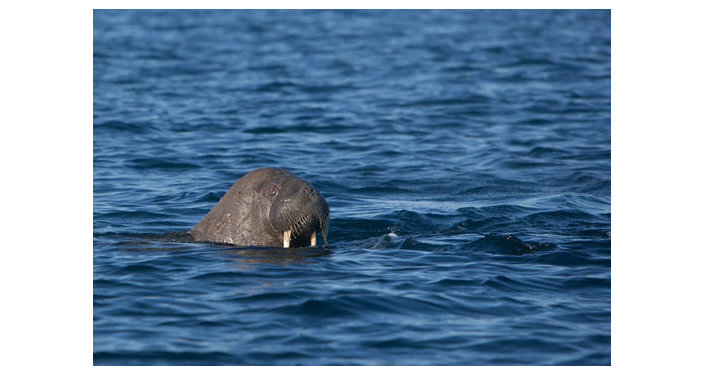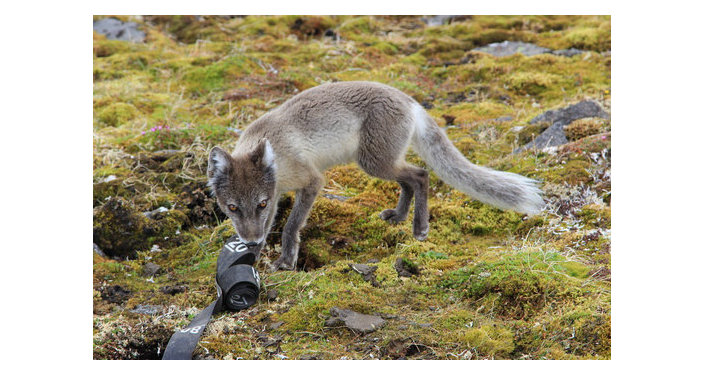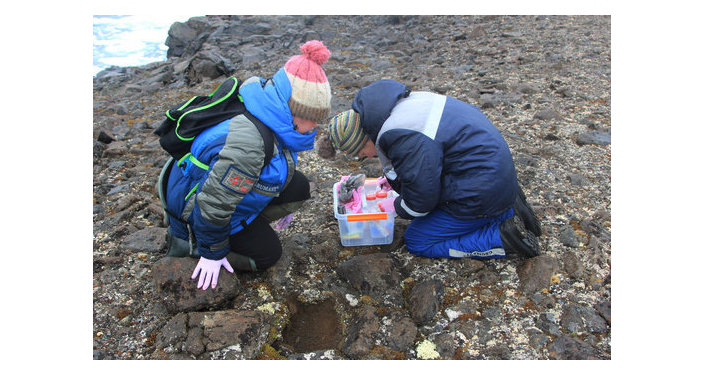The Arctic odyssey of the vessel Professor Molchanov
Konstantin Zaikov is confident that his statement is justified, although the trip involved 58 scientists from Russia, the Netherlands, Sweden, Switzerland, Germany, France, Cuba and Bulgaria, but not from Greece. They met polar bears and walruses, rather than Cyclops, Scylla and Charybdis. Moreover, the explorers sighted the black-browed albatross in the Arctic. A native of the South Atlantic, this bird is seldom seen in the Arctic and is therefore almost mythical.
"Unpredictable weather and encounters with the animal world forced us to adjust our route and activities. The 2017 Arctic is a contradictory place: we saw large drifting ice formations; and an early summer on certain parts of Franz Josef Land, with flowers blooming in some places. It's a real adventure when you don't know what to expect in this part of the Arctic," Zaikov believes.

© The Northern (Arctic) Federal University
Drifting ice formations and fog repeatedly forced the researchers to abort their landings. But they were able to work on islands where no landings had been planned. For example, fast shore ice prevented them from visiting Graham Bell Island. So they conducted soil and environmental research on the Alger and Heiss islands. "Data obtained on Heiss Island allowed our colleagues from the Academy of Sciences to make a truly fundamental conclusion in the area of Arctic soil science and soil landscapes," Zaikov said. In the 1950s-1970s, this area resembled an icy desert, but the island's animal and plant life is now thriving due to climate change.
But that is normal
It is commonly believed that global climate change has a major negative impact on the environment. But Konstantin Zaikov and Sergei Goryachkin, Head of the Geography and Soil Evolution Department, Institute of Geography of the Russian Academy of Sciences, hope that climate change can lead to increased biodiversity.
"The greening of the Arctic will increase its biodiversity and productivity. Since it will also increase food resources, it is good for economic activities, for people, and certain species of birds and fish. Because it is cold in the Arctic, only the most resilient species, which may also be found in other parts of the world, can live there. However, they have to adapt, but they will feel more comfortable in a more friendly environment; and new species will appear," Zaikov said.

© The Northern (Arctic) Federal University
The researchers saw some bird species, during the expedition, that are on the verge of extinction in Norway. In the Russian Arctic, however, their population is growing, Zaikov noted. Researchers were probably not even surprised to see the black-browed albatross, which is usually found in the South Atlantic.
It turns out that what is good for the black-browed albatross is bad for the polar bear.
Research results
Researchers conducted marine, atmospheric and ground research in seven areas. Meteorologists measured aerosol concentrations in the atmosphere and used the AWS-2710 system. The oceanographic team collected 200 water samples at 46 stations and two seabed cross-sections in the Barents Sea and at separate stations on the Franz Josef Land Archipelago. Scientists from the Arctic and Antarctic Research Institute recorded fluctuations during the circulation of Atlantic water masses near the Northeastern Trench and between the Novaya Zemlya and Franz Josef Land archipelagos after a three-year respite. These fluctuations are caused by a warm current from the Gulfstream's Fram offshoot. And experts recorded another warm current nearby.
Marine biologists collected 37 zoo-plankton samples that will be carefully studied in a laboratory at the Arctic and Antarctic Research Institute. They also extracted and identified 14 seabed cross-sections and collected over 100 samples for conducting physical-chemical, microbiological and other laboratory tests. During geological research, scientists from Novosibirsk State University collected 125 specialized samples for paleo-magnetic research.

© The Northern (Arctic) Federal University
Scientists conducted meta-genome research on the Franz Josef Land and Novaya Zemlya islands, and they took about 44 samples, including soil and seaweed samples, bird eggs, cod-and-haddock liver and fillet samples for analysis.
Mega-grant
Researchers worked under a mega-grant aboard the Professor Molchanov. This document with a complicated name implies that scientists should understand how various toxic substances can penetrate the human body via the food chain and cause numerous health disorders, including cancer. "It's important to understand how dangerous this situation is in the Arctic region, what species have the highest toxic-substance concentrations and where these substances come from," Zaikov explains. Indeed, people living in some Arctic areas have accumulated substantial toxic substance volumes in their bodies.
"By studying their food chains, we have found that certain bird species arriving in the Arctic from other regions are the main carriers of these substances. Some bird species flying via China and South Korea become contaminated with pesticides from industrial plants, they eat contaminated food and bring these substances to the Arctic," Zaikov said. Students, members of the expedition, collected bird samples, bird eggs and samples of the fish that are eaten by the local residents and conducted tests to determine the content of any toxic substances.
Scientists managed to collect dovekey, glaucous-gull and eider-duck eggs on Franz Josef Land Archipelago. Moreover, postgraduate students from Northern (Arctic) Federal University intend to study various fish species, including cod and haddock.
"We are interested in the fish-body parts that are eaten by the indigenous ethnic groups and in fish livers. Just like fatty tissue, the liver can accumulate pollutants. We will scan samples for heavy metals, including mercury, cadmium and lead, and we'll also conduct a quantitative chemical test of pesticides and poly-chlorinated biphehyls. Most likely, we'll discover traces of insecticides and herbicides, including DDT and Mirex," a university postgraduate student, Nikita Sobolev, said.
The postgraduate students have sealed the samples collected during the expedition. The material will be studied at the university's Arctic bio-monitoring laboratory using the latest analytical equipment that was purchased for this purpose. International expert Yngvar Thomassen, an analytical chemistry professor from Norway, will oversee the research in Arkhangelsk.
"This research is topical today because it is very hard to monitor the transfer of contaminants via the food chain because every organism accumulates the pollutants, and they are passed on via the food chain. The coastal indigenous people are the final link. They are the most susceptible to these substances because they regularly eat fish and poultry," Anna Trofimova added.

© The Northern (Arctic) Federal University
The Arctic Floating University expedition involved project partners, namely, experts from Novosibirsk State University who are responsible for the geological segment's research and educational aspects. With the support of the 5/100 project, Nikolai Mikhaltsov, a research associate with the Laboratory of Central and Eastern Arctic Geodynamics and Paleo-Magnetism, Novosibirsk State University Professor Dmitry Metelkin, a research associate with the Institute of Oil and Gas Geology and Geophysics of the Russian Academy of Sciences' Siberian Branch, and Viktor Abashev, a postgraduate student with Novosibirsk State University's Geological and Geophysical Department, took part in the expedition.
"We have visited the areas with the most ancient manifestations of volcanic activity (about 150-190 million years ago) in the archipelago, including Hooker and Northbrook islands and Alexandra Land Island. Today, we are witnessing a struggle between advocates of two diametrically opposite concepts regarding the history of volcanic activity. The ‘classic' or ‘generally accepted' concept on the one-time and short-term period of intensive volcanic activity about 130 million years ago is refuted by new data. This data was first obtained by geologist Yuri Karyakin from Moscow and later indirectly confirmed through research with him. Our task was to collect as much evidence as possible of this alternative viewpoint during the expedition," Nikolai Mikhaltsov said.
It is all about the people working in the Arctic
Once the expedition returned to the port, Konstantin Zaikov talked about the Arctic specialist training program. In cooperation with the Federal Service for Hydrometeorology and Environmental Monitoring, the Northern (Arctic) Federal University is training specialists under 136 programs including hydrometeorology, space monitoring, chemistry, engineering and many others. They are closely studying the processes taking place in the Arctic and are currently developing solutions. For example, they are developing new materials and structures for construction projects in high-latitude Arctic regions. Climate change, as mentioned above, may lead to the thawing of the permafrost, under which entire cities, such as Norilsk, were built.
"The Yamal Peninsula has a well-known problem with sinkholes caused by explosions of gas hydrates. Imagine if an explosion occurred near a gas pipeline or in a place where people live. To avoid this, we need to monitor the situation," Zaikov said.
The first results of the expedition are to be published this autumn.
